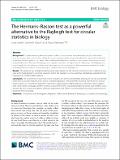Files in this item
The Hermans–Rasson test as a powerful alternative to the Rayleigh test for circular statistics in biology
Item metadata
| dc.contributor.author | Landler, Lukas | |
| dc.contributor.author | Ruxton, Graeme D. | |
| dc.contributor.author | Malkemper, E. Pascal | |
| dc.date.accessioned | 2019-08-12T12:30:07Z | |
| dc.date.available | 2019-08-12T12:30:07Z | |
| dc.date.issued | 2019-08-07 | |
| dc.identifier | 260532368 | |
| dc.identifier | 3738ce16-d216-4119-9390-df454518682d | |
| dc.identifier | 85072052063 | |
| dc.identifier | 000479221900001 | |
| dc.identifier.citation | Landler , L , Ruxton , G D & Malkemper , E P 2019 , ' The Hermans–Rasson test as a powerful alternative to the Rayleigh test for circular statistics in biology ' , BMC Ecology , vol. 19 , 30 . https://doi.org/10.1186/s12898-019-0246-8 | en |
| dc.identifier.issn | 1472-6785 | |
| dc.identifier.other | RIS: urn:B4072E873738BA8B12CA90D99AC0BFCA | |
| dc.identifier.other | ORCID: /0000-0001-8943-6609/work/60630857 | |
| dc.identifier.uri | https://hdl.handle.net/10023/18292 | |
| dc.description.abstract | Background: Circular data are gathered in diverse fields of science where measured traits are cyclical in nature: such as compass directions or times of day. The most common statistical question asked of a sample of circular data is whether the data seems to be drawn from a uniform distribution or one that is concentrated around one or more preferred directions. The overwhelmingly most-popular test of the null hypothesis of uniformity is the Rayleigh test, even though this test is known to have very low power in some circumstances. Here we present simulation studies evaluating the performance of tests developed as alternatives to the Rayleigh test. Results: The results of our simulations demonstrate that a single test, the Hermans and Rasson test is almost as powerful as the Rayleigh test in unimodal situations (when the Rayleigh test does well) but substantially outperforms the Rayleigh test in multimodal situations. Conclusion: We recommend researchers switch to routine use of the new Hermans and Rasson test. We also demonstrate that all available tests have low power to detect departures from uniformity involving more than two concentrated regions: we recommend that where researchers suspect such complex departures that they collect substantially-sized samples and apply another recent test due to Pycke that was designed specifically for such complex cases. We provide clear textual descriptions of how to implement each of these recommended tests and encode them in R functions that we provide. | |
| dc.format.extent | 8 | |
| dc.format.extent | 1686521 | |
| dc.language.iso | eng | |
| dc.relation.ispartof | BMC Ecology | en |
| dc.subject | R functions | en |
| dc.subject | Animal navigation | en |
| dc.subject | Migration | en |
| dc.subject | Emlen funnel | en |
| dc.subject | Behaviour | en |
| dc.subject | Biostatistics | en |
| dc.subject | Circadian | en |
| dc.subject | Chronobiology | en |
| dc.subject | QH301 Biology | en |
| dc.subject | NDAS | en |
| dc.subject.lcc | QH301 | en |
| dc.title | The Hermans–Rasson test as a powerful alternative to the Rayleigh test for circular statistics in biology | en |
| dc.type | Journal article | en |
| dc.contributor.institution | University of St Andrews. School of Biology | en |
| dc.contributor.institution | University of St Andrews. Centre for Biological Diversity | en |
| dc.identifier.doi | 10.1186/s12898-019-0246-8 | |
| dc.description.status | Peer reviewed | en |
This item appears in the following Collection(s)
Items in the St Andrews Research Repository are protected by copyright, with all rights reserved, unless otherwise indicated.

